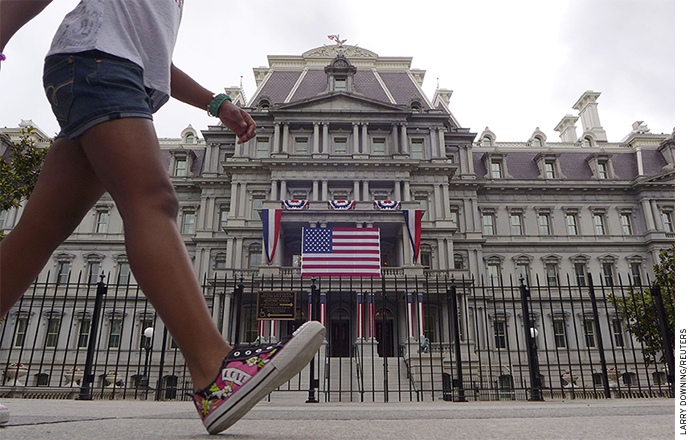
The Obama administration relied on its regulatory power to advance its agenda across a broad range of policy areas in the face of an uncooperative Congress. [i] Where they saw expedient policy solutions, many others saw executive overreach—but individual views on the appropriate balance of power are changing quickly with the impending transition to a Trump administration.
With a Republican House, Senate, and presidency, regulation is likely to be less of an issue in the near future. But some regulation is here to stay: Congress cannot provide the level of specificity needed to implement all laws, which often explicitly mandate further regulation. And there is an important place for evidence in the regulatory process. This post provides an overview of how the process works and how researchers can engage with it to promote evidence-based policy.
A quick primer on the regulatory process and cost-benefit analysis
Though regulations are written by executive branch agencies and not approved by Congress, they ultimately carry the force of law. Agencies seeking to regulate—at times, due to legislative mandates for them to do so—must follow a process set forth in the Administrative Procedure Act. [ii] Agencies post a Notice of Proposed Rulemaking (NPRM) in the Federal Register, providing background on the issue, the language of the proposed rule, and a required regulatory impact analysis. This begins a sixty-day “notice and comment” period during which the public may submit comments for the record. The agency proposing the rule must respond to these comments before they can issue a final rule (the “reg”).
To ensure that these regulations help more than they hurt, Executive Orders 12866 and 13563 mandate cost-benefit analysis (CBA). The Office of Information and Regulatory Affairs (OIRA), a unit within the White House’s Office of Management and Budget, must review proposed and final rules and their CBAs before the rules can be issued. If you are looking for a CBA in any proposed or final rule in the Federal Register, see the “regulatory impact analysis” section.
Cost-benefit analysis in practice
In practice, the regulatory process and its use of CBA does not always comport with the terms set out in these executive orders. [iii]
CBAs can be technically extensive (especially environmental ones—here’s a recent example), at times looking like textbook examples with nuanced takes on discounting and how to infer values for goods not traded in the marketplace (e.g., time, life). They also can be quite minimal, fulfilling the legal obligation in name only.
The U.S. Department of Education’s recent proposed rule for Title I supplement not supplant (SNS)—which, post-election, is not anticipated to become a final rule—provides an example of a weak regulatory impact section (see pages 61154-61156 of the NPRM), radically different than anything someone who has studied CBA would imagine. Most blatantly, it did not quantify benefits, and—despite extensive discussion of administrative costs—ignores the broader potential negative impacts or social costs. It also did not discuss what alternative approaches, and therefore could not discuss their costs and benefits. Nonetheless, the NPRM asserted that the net benefits of the proposed rule are positive, and that the Department chose “those approaches that maximize net benefits,” mirroring the language in Executive Order 13563.
Recommendations for policymakers
If the Trump administration, like the Obama, George W. Bush, and Clinton administrations, chooses to issue its own standards for cost-benefit analysis with a new executive order, it should retain language consistent with a textbook definition of CBA: maximizing net benefits. This “bottom-line” approach may well appeal to a president-elect who thinks government should function more like a business.
Executive agencies should use CBA to guide their decisionmaking throughout, rather than bringing it in at the end to justify a political choice.
And the staff of OIRA should ensure that regulations—from all agencies—at a minimum describe the nature of their own costs and benefits and those of at least one alternative.
You can’t fill in the blanks of costs and benefits in any meaningful way using only readily available raw data. Policymakers need a sense of how the parties affected by a new regulation will respond to it—and their best guesses should be informed both by regulated parties and by research.
Recommendations for researchers
Researchers can contribute to the democratic process in any administration by following regulatory processes (did you know @EDFedRegister is on Twitter?) and submitting public comments on draft rules. Are the assumptions behind the proposed rule consistent with evidence? Are the costs and benefits estimated in a way that reflects what we know about the policy area—or at all?
These comments are typically dominated by those most directly impacted by the rules—the so-called “stakeholders.” But researchers have a lot to add here, whether drawing upon specific findings or simply taking a common-sense approach to CBA, which need not be highly technical.
I recently submitted public comments on the proposed SNS regulation, which emphasized the importance of considering how proposed changes would affect spending decisions and, ultimately, students, as opposed to simply calculating how many dollars would be transferred from one school to another. [iv] They serve as an example of how researchers can bring an analytic eye to the process even when there is not an existing study addressing what may be a highly particular or novel regulatory issue.
In contrast, Polikoff’s public comment on draft ESSA accountability rules drew heavily on a large empirical literature as it argued against a federal mandate for states to use proficiency rates as measures of school performance. [v] I found the comment very useful because it was organized around specific policy arguments, using research findings to explain why. Polikoff took an approach that could serve as a model for future comments, circulating a draft via Twitter which prompted 53 researchers to join as signatories, in addition to teachers and other interested parties.
The regulatory process provides a unique opportunity for researchers and the public at large to engage with policy. We should take advantage of it, in any administration.
— Nora Gordon
Nora Gordon is associate professor of public policy at Georgetown University, research associate of the National Bureau of Economic Research, and non-resident fellow of the Brookings Institution.
This post originally appeared as part of Evidence Speaks, a weekly series of reports and notes by a standing panel of researchers under the editorship of Russ Whitehurst.
The author(s) were not paid by any entity outside of Brookings to write this particular article and did not receive financial support from or serve in a leadership position with any entity whose political or financial interests could be affected by this article.
Notes:
[i] “Appelbaum, Binyamin and Michael D. Shear. Aug. 13, 2016. “Once Skeptical of Executive Power, Obama Has Come to Embrace It.” The New York Times.
[ii] Office of Information and Regulation, Office of Management and Budget. “Frequently Asked Questions.”
[iii] Heinzerling, Lisa. 2014. “Inside EPA: A Former Insider’s Reflections on the Relationship Between the Obama EPA and the Obama White House.” Pace Environmental Law Review 31(1).
[iv] Gordon, Nora. 2016. Comment on FR Doc # 2016-20989.
[v] Polikoff, Morgan. 2016. Comment on FR Doc # 2016-12451.



